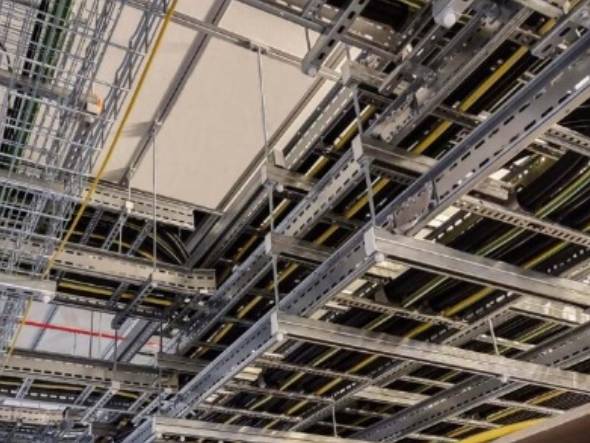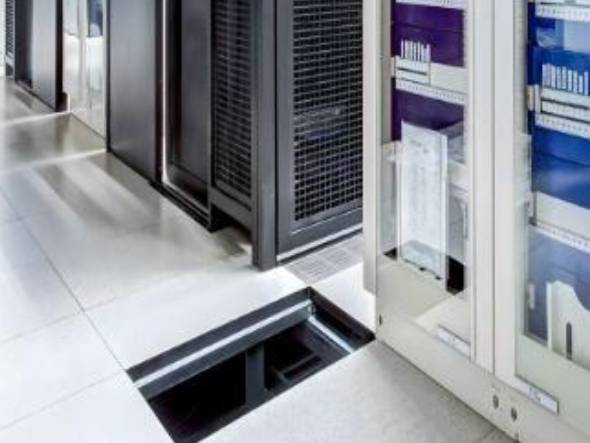Data Center Floor Accessories
One of the key conditions for the operability of data center equipment is the removal of heat that is released during its operation. This function is performed by special devices, the general name of which is cooling systems. Modern air conditioners provide both the maintenance of the temperature within the specified limits and the necessary parameters of humidity, however, it is precisely cooling that is their main purpose.
To remove excess heat, air is used: the air conditioning system continuously supplies cold air to the active equipment in the server room and removes heated air.
How are chillers different?
Air conditioners are divided into two groups:
- direct expansion devices with built-in freon circuit. This is how conventional household and industrial air conditioners work.
- air conditioners that run on chilled water or water with ethylene glycol, which acts as a heat carrier. Special devices are responsible for cooling water in such systems – water coolers, cooling towers, dry coolers, adiabatic installations. The most complex of these devices is a water cooler, or chiller.
A chiller is a versatile device that is capable of both cooling and transporting a chiller to the desired point in the system. It can work in all environmental conditions, indoor and outdoor. Other systems are not so versatile: a dry cooler cannot function indoors and has limitations during summer operation, cooling towers and adiabatic systems, on the contrary, are difficult to use at subzero temperatures.
The simplest chiller is a unit with a freon circuit and a heat exchanger that cools the coolant. A more sophisticated system may include a remote condenser, inline pumping groups, a freecooling system, an irrigation system, or adiabatic cooling.
Depending on the complexity of the chiller design, the list of routine maintenance work can be either very short or very long. Such work can take from noon to two days and is usually carried out by two specialists.
What kind of work does maintenance work on the chiller?
1. General inspection
First of all, a visual inspection is carried out. It is necessary to check for mechanical damage, dirt on the heat exchangers, traces of leaks. Particular attention is paid to external heat exchangers – condensers. This inspection is necessary to avoid the premature need for more serious maintenance work. If a leak is found on the water cooler or the heat exchanger is dirty, no further work is carried out until the deficiencies are eliminated.
Unlike classic air conditioners, the chiller is a monoblock – a unit in a single body that stands on a frame and is located in a confined space. It can be completely walked around, viewed from above with a stepladder.
Inspection complicates the difficult access to the elements that are located in the depth of the device, inside the case. Often they cannot be seen with the naked eye; you have to use mirrors, cameras, and sometimes endoscopes.
Common mistakes when servicing the chiller:
- Insufficiently thorough external examination: the engineer walks around the monoblock, but does not look behind the pipe, behind the heat exchanger, behind the pump.
- Lack of inspection inside: if the chiller has a V-shaped condenser, for a better view, you need to remove the plate that muffles it.
Many sudden equipment failures are associated with ignoring these points.
2. Inspection and check of tightening of threaded connections
The task of the chiller is to cool the liquid: pure water or mixed with ethylene glycol. Therefore, the design includes many pipes that are connected using threaded connections. Even if there are no signs of a leak at the time of service, this does not guarantee that it will not happen soon.
There is a particularly high risk of leakage near the pumps as they transmit vibration to the pipes. Therefore, it is necessary to check all screw connections and tighten them. The same procedure is performed on the elements of the freon circuit – tighten the nuts of the pipe connections with compressors, pipelines, especially those with vibration.
What happens if you neglect these works? Leakage will occur. If this happens in the water circuit, the result, at least, will be a loss of coolant. Air will enter the system, and the operation of the final device – an air conditioner or fan coil – will become ineffective. The temperature in the server room will rise while the fan coil unit is operating at full capacity, unable to cope with cooling. It will be difficult to diagnose the problem in time, especially if the leak occurred on the street.
In the event of a leak in the refrigerant circuit, the parameters of the system will be violated and all elements will work first ineffectively and then incorrectly. As a result, the device may stop working altogether. Such a leak will be especially noticeable in the cold season, the chiller will generate a “low pressure alarm” error.
3. Inspection of coolant pipelines
The maintenance of the chiller is not limited to the inspection of the monoblock. Since the chiller is part of the cooling system, there is no point in maintaining the chiller in isolation from the entire system. You can carefully configure and maintain a water cooler, but it will work ineffectively, incorrectly, or completely fail, because the line through which the coolant is transported is not serviced.
The coolant lines are usually covered with an insulating sheath to prevent condensation from forming. It is necessary to check the integrity of this shell, inspect the elements with valves for leaks. The pumps are examined visually, and the presence of unusual mechanical noises, indicating a pump malfunction, is determined by ear.
If a mixture of water with ethylene glycol acts as a coolant, the quality of the mixture itself is also checked.
4. Cleaning the heat exchangers
Heat exchangers can be of different types. According to the regulations, the heat exchanger that cools the water is cleaned every 10 years. Cleaning may also be necessary if the chemical analysis of the coolant shows severe contamination. This is a complex and time-consuming operation; it is not included in the usual maintenance.
There are also heat exchangers that give off heat to the air – a freon condenser or a heat exchanger for an integrated freecooling system. They need to be cleaned in the same way as outdoor units on air conditioners – using a pressure washer, sometimes with a blower. Such work must be included in the maintenance schedule, since the contamination of the heat exchanger reduces the cooling efficiency.
5. Revision of the refrigerant circuit
Next, you need to visually inspect the circuit and the freon line for leaks, check the amount of freon in the circuit. Refuel if required.
It is important to take into account that, unlike air conditioners, in which the indoor unit is located inside the room, and the external one is outside, the chiller is a monoblock. Since the length of the refrigerant circuit is short, it reacts little to changes in the ambient temperature. With proper operation, no leaks should occur. Therefore, the need to refuel with freon should alert and make you pay special attention to the tightness of the circuit.
Just like in air conditioners, in chillers, the acid level in the oil and the moisture content are checked using indicator sight glass. A more accurate analysis is carried out using the acidity test of the oil. In general, all the same remarks are valid here as when checking the refrigerant circuit in air conditioners. A detailed description of these works is in our previous article.
Then the condensing pressure is monitored. If necessary, the system is adjusted – here such work is permissible, they may be dictated by a change in the external temperature.
The engineer determines the amount of superheat, controls the operation of the thermostatic valve, checks the main control points of the controller – how it turns on and off the compressors, pumps, as determined by the sensors. They compare temperatures and other parameters – pressure, flows, watch how the controller reacts to their changes.
Upon completion of the main check, it is necessary to check the optional equipment – built-in freecooling, compressors, pumps.
6. Checking the heating medium circuit and pumping group
Since the chiller cools the heat transfer fluid, its design includes a water cooling circuit and pumps.
As part of maintenance, it is necessary to check the correct operation of the pumps, to inspect for signs of leaks. The operating hours of the devices are also monitored – if they have reached the value recommended by the manufacturer, the oil seals are replaced. If there is a leak inside the pump, the oil seals must also be replaced.
It is necessary to check if there have been any trips due to an accident, measure the currents, adjust their level, if necessary.
Pumps that regulate the flow of the coolant are additionally checked for correct adjustment.
What points are often overlooked during maintenance of the pump group?
- Replacement of oil seals only in case of leakage.
It is imperative to change the seals as soon as the pump has operated for the recommended replacement hours – even if no leaks have yet been observed. After the resource is depleted, the oil seal will not only leak sooner or later, but also waste the seat. After that, replacing the oil seal will no longer solve the problem.
- Operation of the pump after the replacement period.
The pump bearings have a limited resource, while they cannot be replaced separately in most cases – you need to change the entire pump. By and large, you can continue to use the pump after it has run out. But in case of a sudden failure, you will have to take emergency actions to replace it. Therefore, we recommend that you have a new pump in stock in advance, or at least prepare a contract with a supplier who can quickly bring a new pump.
Alternatively, you can buy a new pump to replace the old one according to the regulations, and give the old one for repair to a workshop, where they will replace bearings, an oil seal, gaskets, clean the chamber, and balance it. Such a pump is again ready for operation and can remain in the warehouse as a backup.
A separate issue is related to the definition of operating hours. Most modern chillers are equipped with a counter controller. Often these devices are equipped not with a single, but with a double pump for a reserve, and the controller not only counts the hours, but also changes the rotation so that they wear out evenly. If there is no meter, we can assume that the pump develops a resource in an average of 5-7 years.
7. Maintenance of the electrical part
When the main work in the mechanical and hydraulic systems of the chiller is completed, you need to check the currents at all key points of the electrical equipment, tighten the power contacts and contacts of low-current circuits.
The need for regular maintenance of equipment is, of course, obvious. The costs and risks associated with a sudden shutdown of the cooling system can be eliminated only through timely prevention of all components and mechanisms. Considering how many errors an inexperienced technician can make, it is advisable to contact certified service center air conditioning specialists for routine maintenance.





